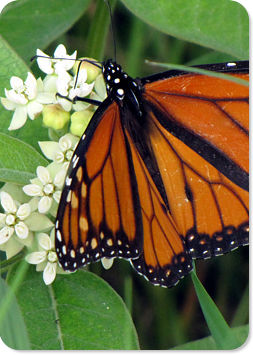 Monarchs of the air, majestic, but frail.(Published in the Winnipeg Free Press, Oct. 29, 2000) Remember that big monarch butterfly flitting through your garden last August? Do you know where it is now? Mexico! By now, late October, it's sitting in a fir tree in a valley in the Transvolcanic Mountain range, west of Mexico city, along with about 50 million other monarchs. There it will stay for our winter months, resting in the cool mountain air, clinging to a branch, along with so many other monarchs that you can't see the tree. It will wait for the spring and the chance to start the journey northward again. And I use the word "start" intentionally, because no Manitoba monarch will ever complete the journey back. Let me back up a bit. Each year, about the first or second week of June, monarchs show up in southern Manitoba, having flown here from the south. The females have already mated and as they fly northward they lay eggs on milkweed plants they find along the way. They keep flying north and laying eggs until they die, only a few weeks after they emerged from chrysalises as adult butterflies. The monarchs that have been migrating northward in the spring will never fly south to Mexico. Ten days after it's laid, each egg hatches into a tiny caterpillar which gorges on milkweed leaves for 3 weeks, growing to 50 mm in length, then crawls off to find a safe place to make its chrysalis. In another 7 - 10 days a new butterfly emerges. From egg to winged adult takes each monarch about 6 weeks. The first monarchs born in Manitoba begin to emerge as adults in late July. Monarchs born here will be different from their parents. Decreasing day lengths and cooler temperatures as they developed results in the emergence of butterflies that won't mate and won't fly north. Their compasses will be set to "fly south" and they will embark on a prodigious journey that will take them to central Mexico, 3000 km away. Traveling as much as 50 km a day they arrive in central Mexico by late October. Their journey is fueled by nectar they gather from flowers along the way. They must gather enough to fuel their journey and provide them with body fat to see them through to the next spring. Using the earth's magnetic field and the funnel-like geography of North America, our monarchs eventually meet up with all the other "fly south" monarchs from eastern North America in a few small valleys in central Mexico. Once there, they loose their urge to fly south and cluster together on the branches of trees. After about 5 months of loafing around, these former "fly south" butterflies begin to change. Increasing temperatures and lengthening days "flip their switches" over to "fly north" and they become reproductively active, thus ensuring the continuation of their species, but also ensuring their own demise. In mid March the monarchs leave the overwintering sites and head north. By the time they reach Texas, our Manitoba-born females start laying eggs, but their journey will end soon after. Most probably never make it much further than Texas, but their offspring will be born to "fly north" and these will start other generations. It is the children or grandchildren of our Manitoba monarchs that make it back here. Then they, in turn, will lay their eggs and die, leaving behind the next generation that will fly back to Mexico to keep the cycle going. [Update: recent research has shown that a small percentage of Manitoba-borm Monarchs may actually make it back from Mexico!] As you might imagine, the conservation of monarch butterflies is a tricky affair. The concentration of the overwintering butterflies in a few mountain valleys in Mexico puts them in a precarious situation. Mexico now protects much of the overwintering sites, but logging activities near these may alter the local environment. On their way north and south the butterflies must have dependable supplies of milkweed for their caterpillars and nectar for themselves. In the US and Canada land management and farming practices often conflict with these needs. To ensure that the incredible multi-generational migration of monarchs continues requires a truly international effort. It requires that we are all aware of this wonder of nature, that we care, and that we instruct our governments how to behave. Thanks for reading! Got to the: What's Outdoors Front Page | Next Column >
|
||
|
For more on this topic, here's some articles in NatureNorth.com: Marvelous Monarchs | Butterfly Gardening More on butterflies and moths in Nature North: Mourning Cloak Butterfly | Giant Silk Moths | White Underwing Moth |
||
| You can help NatureNorth produce more great articles with a secure donation through PayPal. Our Google Adsense ads pay our server costs, but that's about it. To learn more follow this link: Support NatureNorth. Thank-you! | |
Return to the: NatureNorth.com Front Page
Or pick a seasonal issue to visit:
